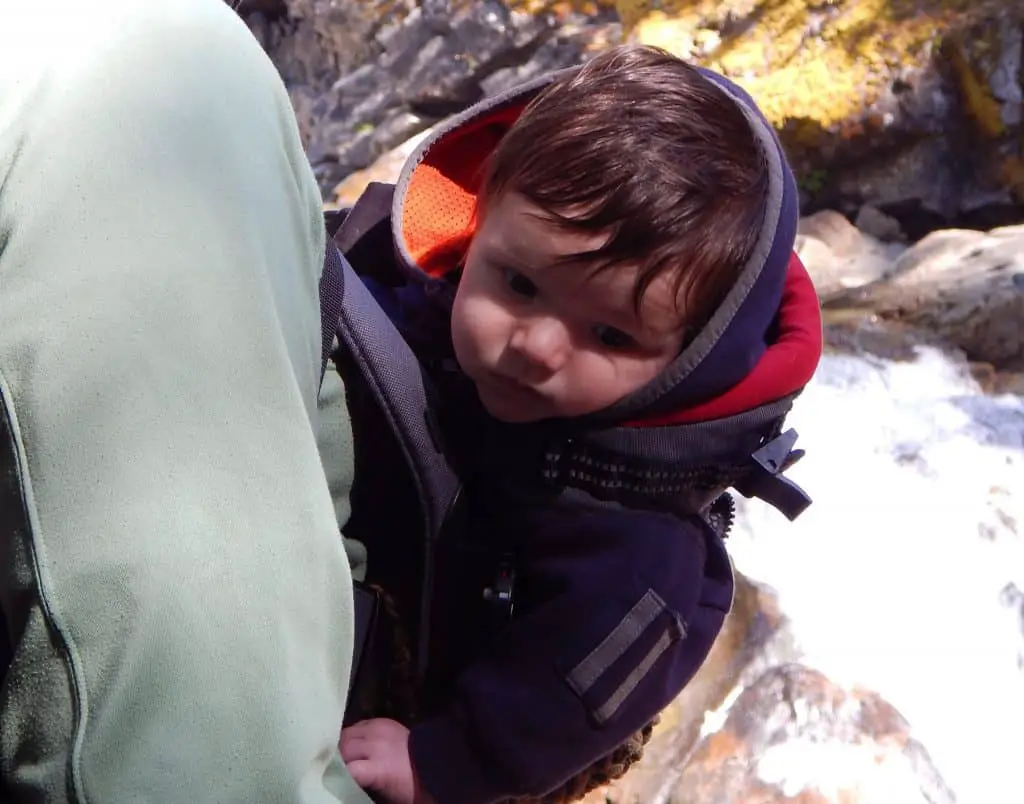Once you have a baby it can really put a damper on your hiking life. With a new little person, you have many new responsibilities and limitations that tend to hinder your ability to do outdoor activities. The good news is that hiking is something you can still do. Of course, you’ll have limitations (though not as many as you might think) and it’s a great way to introduce your new one(s) to the outdoors.
A good child carrier will help you and your child be comfortable while hiking. There are two types of child carriers for hiking: front carriers and backpack carriers. Front carriers are the best option for hiking with children less than 6 months old. Babys can generally use backpack carriers once they are about 6 months old (once they can support their head and neck).
Child carriers have made it possible for us to hike with our kids. It’s not always easy, but it is possible and we’ve had a lot of good hiking adventures even with young children. The best part is that our children get to experience the outdoors and adventures with us.
Start with a Front Carrier
There are several different carrier options depending on your baby’s age. We’ve started both of our kids out in a front (or chest) carrier. Front carriers are designed for children ad young as newborns and can be used until your child gets big enough that it’s uncomfortable to carry them in front. By the time the child’s mother has recovered enough from birth to walk for a mile or so, your new baby will probably be developed enough to come along in the front carrier.
Many different front carrier designs exist. We have one that was given to us by a friend. It’s basically a reverse backpack with a pouch in the front that unlatches to fit the baby into. It’s not the most comfortable thing to wear, but it’s manageable for a three-mile hike, which is fine because that’s about all our babies have been able to handle.
There are other front carrier options. I’ve seen several designs similar to the one we own plus others that wrap around and swaddle. If you’re not sure what will work best for you try a few out and see which one you find most comfortable and easy to use.
Once our babies get zipped in, it’s only a matter of a few minutes before they fall asleep. They usually remain asleep for the entire hike (or until they get hungry).
If the sun’s out we use a nursing cover to keep them shaded. The nursing cover attaches around your neck and covers the entire front of your body. They’re lightweight and almost unnoticeable.
When it’s cold out, we wear a coat or jacket that has a little extra room and zip it up over the carrier. With your baby next to your chest and a layer covering them, they will stay plenty warm in almost all conditions. If your core starts to get cold, then it’s probably time to head back.

Upgrade to a Backpack Carrier
At about 6-months old, most children have developed enough neck strength and stability to ride in a backpack carrier. Of course, each child is different and there is no exact age. If you’re unsure about your child’s ability to ride safely in a backpack carrier, you should consult a physician.
Backpack carriers present new opportunities and new challenges. I, for one, find backpack carriers much more comfortable than front carriers. We’ve done several hikes of five miles or more with our backpack carrier, and even backpacked in 7 miles for an overnight trip with our son.
It is harder to keep children warm in a backpack carrier. Toes and feet are especially hard to keep warm because they hang outside of the carrier, far away from the body’s core.
One November we hiked about five miles with our son. The outside temperature was bout 30 °F. We put our boy in a warm, one-piece snow-suit but about halfway through the hike, he started to cry because his feet were cold (we think). He was just wearing his regular shoes with warm socks but it wasn’t enough. After that experience, we invested in some warmer boots and were able to go on some snowshoeing outings later that winter without any problems.
With our daughter, we’ve found that putting the rain cover on the backpack carrier helps trap heat inside and keeps her warm. She is about 7-months old and usually wears a soft, one-piece bear suit. That has kept her warm in temperatures of 35-40 °F.
Choosing a Backpack Carrier
As with front carriers, there are different brands and styles of backpack carriers. For the most part, they all have similar designs with slightly different feature sets.
Before purchasing a carrier, I would suggest trying out a few, preferably with your child in the carrier. The most important thing to consider when choosing a backpack carrier is how comfortable it will be for you and your child. Be forewarned that while backpack carriers are the most comfortable way to carry a child, they are not 100% comfortable. An obvious reason for this is that your child is an awkward shape to put in a backpack, so the load distribution is never perfect. As your kid gets heavier they also get more uncomfortable to carry.
Our family invested in an Osprey Poco. It’s adjustable to fit your child as they grow and to fit different sized adults. It’s relatively comfortable, but not as comfortable as I would like. I can carry 40-50 pounds in my Mystery Ranch hunting pack with as much comfort as I can carry a 30-pound toddler in the Osprey. Still, I’m really glad we have it. We’ve been on a lot of adventures and put on a lot of miles with a kid in that backpack.
Make sure your carrier has enough storage space to carry the essential diapers (clean and dirty), wipes, snacks, extra clothes, warm clothes, favorite toys, and other items that you and your kid need.
Once your baby is old enough to go in the backpack carrier you’ll find you can really increase your hiking range. We’ve had a lot of great experiences with our kids in backpack carriers. One summer, when our son was about 2-years-old, we probably did 20 miles with him during a vacation to Glacier National Park.
Use Your Shoulders if You Have To
My final recommendation is not the preferred method, but it can still work. The good old shoulder ride. That’s right, the method where the kid sits on your shoulders. It’s not ideal, but it is more comfortable than carrying them in your arms. We’ve done a few impromptu hikes this way. One-mile is about as far as I can go before it gets extremely uncomfortable. Still, this method can be useful for a short jaunt.
Conclusion
For parents, hiking with kids can be a chore. It can also be a lot of fun. Usually, it’s a combination of both. We’ve found that the more we hike with our kids the more fun they have and the easier it is the next time. Having the proper transportation for the kiddos really helps them to be comfortable and helps us to be comfortable and go far enough to get at least a little exercise in so we don’t completely lose our mountain legs. If you’re looking to get out with your kid(s) find a carrier option that works for them and get to hiking!
